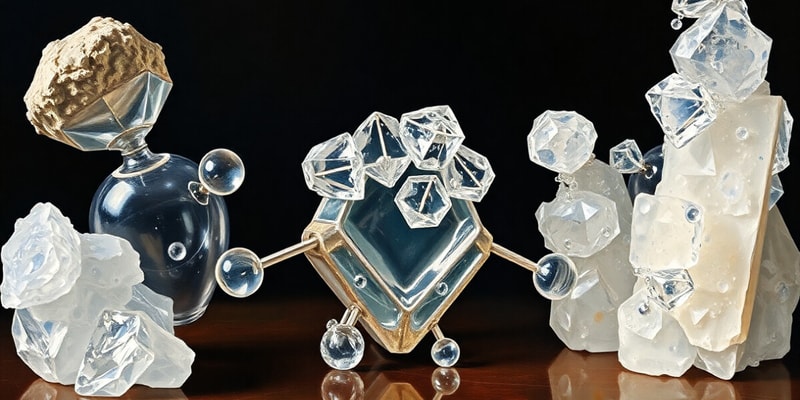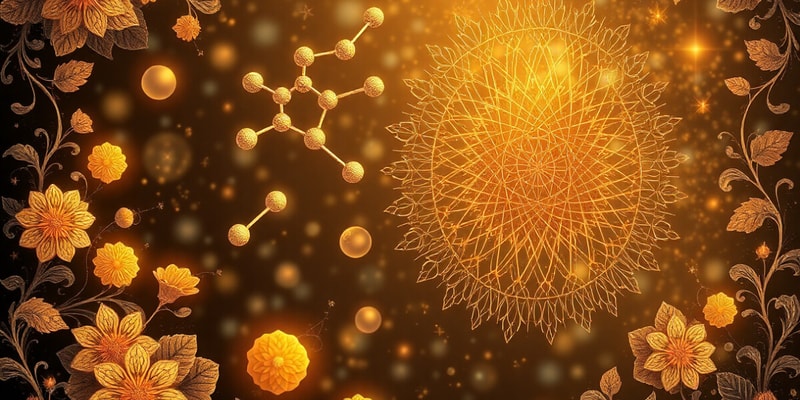Podcast
Questions and Answers
The concept of crystal polymorphism refers to multiple crystalline solid state forms of pharmaceutical compounds, such as paracetamol which has at least four polymorphs.
The concept of crystal polymorphism refers to multiple crystalline solid state forms of pharmaceutical compounds, such as paracetamol which has at least four polymorphs.
False
Amorphous solid forms are non-crystalline states that can affect the solubility of a drug product.
Amorphous solid forms are non-crystalline states that can affect the solubility of a drug product.
True
In a phase diagram with two solid regions, the preference for one crystal form over another depends only on the composition of the mixture.
In a phase diagram with two solid regions, the preference for one crystal form over another depends only on the composition of the mixture.
False
In expressions of equilibrium constants, activities must always be used instead of concentrations.
In expressions of equilibrium constants, activities must always be used instead of concentrations.
Signup and view all the answers
The free energy for a real system can be expressed as GT,P = μA nA + μB nB + μC nC, where μ signifies the chemical potential of components.
The free energy for a real system can be expressed as GT,P = μA nA + μB nB + μC nC, where μ signifies the chemical potential of components.
Signup and view all the answers
For ideal gas systems, total free energy can be expressed as the sum of individual free energies of each component, as with real systems.
For ideal gas systems, total free energy can be expressed as the sum of individual free energies of each component, as with real systems.
Signup and view all the answers
The equation for the free energy of a real system is given by 𝜇𝑖 = 𝜇𝑖° + 𝑅𝑇 ln 𝑎𝑖.
The equation for the free energy of a real system is given by 𝜇𝑖 = 𝜇𝑖° + 𝑅𝑇 ln 𝑎𝑖.
Signup and view all the answers
The relationship for the equilibrium constant is expressed as 𝐾 = 𝑎𝐶𝑐 / 𝑎𝐴𝑎𝐵.
The relationship for the equilibrium constant is expressed as 𝐾 = 𝑎𝐶𝑐 / 𝑎𝐴𝑎𝐵.
Signup and view all the answers
The equation ΔG° = -RTlnKeq represents the free energy change for systems not at equilibrium.
The equation ΔG° = -RTlnKeq represents the free energy change for systems not at equilibrium.
Signup and view all the answers
In ideal gas systems, the concept of activity is less important than concentration.
In ideal gas systems, the concept of activity is less important than concentration.
Signup and view all the answers
In the context of free energy, the variables P, V, T define the thermodynamic state of an ideal gas system.
In the context of free energy, the variables P, V, T define the thermodynamic state of an ideal gas system.
Signup and view all the answers
Chemical potential, μ, represents the contribution of each component to the overall free energy in a real system.
Chemical potential, μ, represents the contribution of each component to the overall free energy in a real system.
Signup and view all the answers
The activity coefficient, denoted as , is inversely proportional to concentration.
The activity coefficient, denoted as , is inversely proportional to concentration.
Signup and view all the answers
The term 𝑅𝑇 ln 𝑎𝑖 in the equation for free energy represents the change in free energy due to temperature and activity.
The term 𝑅𝑇 ln 𝑎𝑖 in the equation for free energy represents the change in free energy due to temperature and activity.
Signup and view all the answers
Stability of crystal polymorphs is independent of environmental conditions such as temperature and pressure.
Stability of crystal polymorphs is independent of environmental conditions such as temperature and pressure.
Signup and view all the answers
Real systems require adjustment of free energy calculations due to their non-ideality, contrasting with ideal gas systems.
Real systems require adjustment of free energy calculations due to their non-ideality, contrasting with ideal gas systems.
Signup and view all the answers
The standard free energy change, ∆𝐺 °, replaces the free energy changes in real systems.
The standard free energy change, ∆𝐺 °, replaces the free energy changes in real systems.
Signup and view all the answers
Activities of components in a solution can be considered equal to their concentrations.
Activities of components in a solution can be considered equal to their concentrations.
Signup and view all the answers
For a real system, the activity defined as 𝑎𝑖 = 𝑖[i] indicates that the activity coefficient modifies the concentration to give activity.
For a real system, the activity defined as 𝑎𝑖 = 𝑖[i] indicates that the activity coefficient modifies the concentration to give activity.
Signup and view all the answers
The equilibrium constant cannot be expressed in terms of concentrations for real systems.
The equilibrium constant cannot be expressed in terms of concentrations for real systems.
Signup and view all the answers
Study Notes
Multiple Solid Phases
- Some pharmaceutical compounds exhibit different crystalline forms known as polymorphs.
- Polymorphism in pharmaceuticals impacts stability (temperature dependent).
- Paracetamol has at least three polymorphs.
- Amorphous (non-crystalline) solid forms are also possible.
- Pharmaceutical manufacturing requires controlling the crystal form to influence solubility and other essential properties.
Phase Diagrams and Polymorph Stability
- Phase diagrams for compounds with two polymorphic forms resemble one-component systems.
- The diagrams contain two solid regions (S1 and S2), representing the two polymorphs.
- The preferred, more stable polymorph changes depending on temperature and pressure conditions.
Dealing with Non-Ideality
- Standard thermodynamic variables (e.g., U, H, S, G) are defined for ideal gas systems but need to be adjusted for real systems (liquids and solids).
- Free energy (G) of a system is a function of pressure (P), volume (V), and temperature (T).
- Total free energy (G) for an ideal system with components A, B, and C is the sum of individual contributions (GA + GB + GC).
Chemical Potential
- Chemical potential (𝜇) represents the contribution of each component to the overall free energy in a real system.
- This value is influenced by the interactions between all components in the system.
Chemical Potential, Free Energy, and Real Systems
- At constant temperature and pressure, the total free energy (GT,P) of a system with three components (A, B, and C) is:
- 𝐺𝑇,𝑃 = 𝜇𝐴 𝑛𝐴 + 𝜇𝐵 𝑛𝐵 + 𝜇𝐶 𝑛𝐶
- 𝜇A, 𝜇B, 𝜇C represent chemical potentials of components A, B, and C, respectively, and nA, nB, nC represents the number of moles.
Free Energy Changes in Real Systems
- At equilibrium: G° = −RTlnKeq
- For a system not at equilibrium: G − G° = RTlnKeq
- For an ideal gas:
- G is free energy, P is pressure, G° is standard free energy, P° is standard pressure, and n is the number of moles.
- The term (P/P°) is analogous to the concentration term in an equilibrium constant, i.e. [A]a.
Free Energy Changes in Real Systems for Non-Ideal Systems
- For a real system (e.g., a solution): 𝜇𝑖 = 𝜇𝑖° + 𝑅𝑇 ln 𝑎𝑖
- ai represents the activity of component i.
- Activities, rather than concentrations, are used in equilibrium expressions, but concentrations can be acceptable approximations depending on the usage.
Activity and Activity Coefficient
- Activity (ai) is not the same as concentration ([i]) but is proportional to it.
- The proportionality constant is the activity coefficient (i): ai = i[i].
Free Energy Changes in Real Systems for a Chemical Process
- For a process like A + B ⇌ C + D, the free energy change (∆𝐺) is:
- ∆𝐺 = ∆𝐺 ° + 𝑅𝑇 ln 𝐾
- The equilibrium constant (𝐾) is:
- 𝐾= 𝑎𝐶𝑐 𝑎𝐷𝑑 / 𝑎 𝑏 𝑎𝐴 𝑎𝐵
- Activities can be replaced with concentrations in certain situations.
Studying That Suits You
Use AI to generate personalized quizzes and flashcards to suit your learning preferences.
Related Documents
Description
Explore the fascinating world of polymorphs in pharmaceuticals with this quiz. Learn how different crystalline forms such as paracetamol's polymorphs influence stability and solubility in drug manufacturing. Understand the importance of phase diagrams and the complexities of non-ideal systems.




